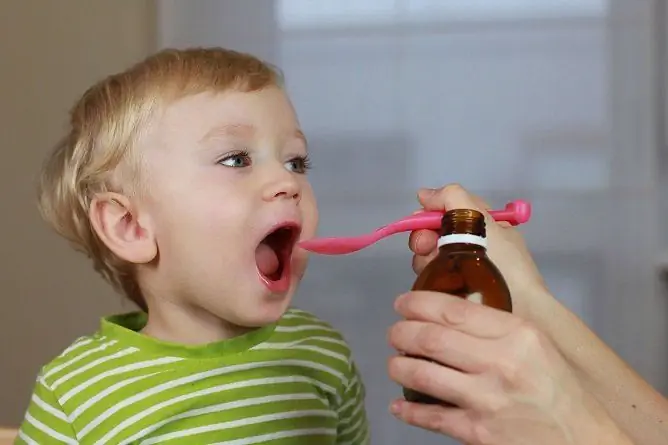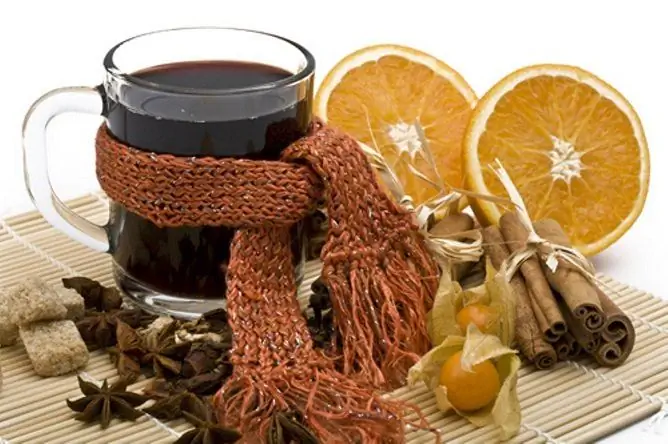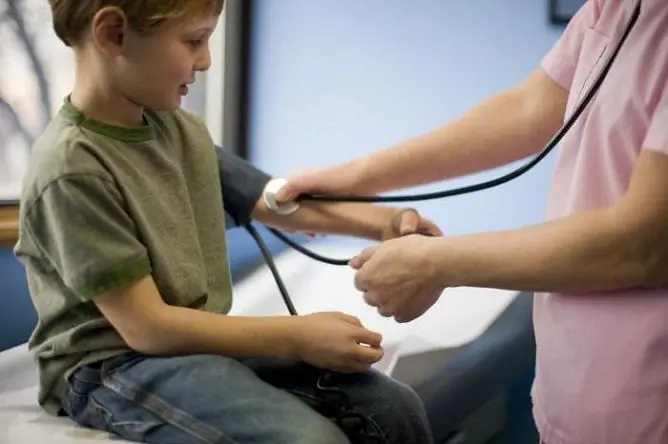- Author Rachel Wainwright [email protected].
- Public 2023-12-15 07:39.
- Last modified 2025-11-02 20:14.
Effective cough remedies for children
The content of the article:
- Which diseases are the most common cough
- Why does a cough occur?
-
Cough medicine
- Secretomotor means
- Mucolytics
- Video
Cough suppressants for children are commercially available in a wide range, but they must be taken extremely responsibly: those drugs that are shown to a child, for example, at 8 years old, may be prohibited for use in a newborn 6 months old.
Effective cough remedies for children are represented by drugs of several groups. Each of them has a specific point of application and causes characteristic changes in the functioning of the respiratory tract. To know what to give a child for a speedy recovery, it is necessary to understand the specifics of diseases accompanied by coughing.

Antitussive medicines for children can only be taken as directed by a doctor
Which diseases are the most common cough
Cough is ubiquitous in pediatric practice, for several reasons:
- the frequency of acute respiratory diseases is steadily increasing, bronchitis in the autumn-spring period develops in about 300 out of 1000 children;
- every year the number of children with increased allergic readiness and allergic pathology of the respiratory tract increases;
- researchers note an increase in the number of chronic forms of diseases accompanied by cough, and a more protracted course of acute processes;
- the resistance of pathogens to the treatment is increasing.
That is why it is extremely important to choose drugs that will help get rid of your cough.
Pharyngitis, laryngitis, tracheitis and bronchitis are in the lead in the list of pathologies accompanied by cough. Bronchial asthma is much less common, and with pneumonia, contrary to popular belief, there may be no cough at all.
All of these diseases can be both infectious and non-infectious.
In the first case, pathogenic bacteria or viruses enter the child's respiratory system by airborne droplets. This happens when an infected person sneezes, coughs, or uses the same cutlery or utensils. Microorganisms are fixed on the mucous membrane, invading its cells, and begin to multiply, provoking active inflammation. The ciliated epithelium, the villi of which sweep away infectious agents, various allergens, dust particles, etc., becomes less active. The protective mucus of the respiratory tract becomes viscous, thick, and its amount increases. Stagnation forms, sputum begins to irritate the receptors, provoking a protective reaction - a cough.
With the non-infectious nature of cough, the mechanism of its occurrence is similar to that presented above, the main difference is the causes of the disease:
- passive smoking, when parents or other relatives of the child regularly smoke in residential premises;
- allergic diseases;
- chronic sluggish diseases of the nose, nasopharynx;
- living in an unfavorable ecological environment (near industrial production, mines, quarries, etc.);
- unfavorable climatic conditions, in particular, damp cold ambient air or, conversely, dry and hot;
- hereditary predisposition to diseases of the bronchopulmonary zone;
- exposure to toxic substances on the mucous membrane of the respiratory tract.
Why does a cough occur?
With the development of inflammation in the mucous membrane of the respiratory tract, the goblet cells located in it begin to intensively produce mucus. If the normal daily amount does not exceed several tens of milliliters, then with illness it increases significantly. In addition, the bronchial secretion becomes difficult to separate, thick. It fits snugly against the walls of the bronchi, making it difficult to remove.
The stagnant contents of the bronchial tree irritate the cough receptors, and a protective reaction of the body occurs - a cough. As soon as a child develops this symptom, we can say that the natural mechanisms for removing mucus from the trachea and bronchi have become untenable.
If the cough is dry, this indicates that the sputum is too viscous, it is not removed from the bronchi efficiently enough. In this case, it is called unproductive, since such a cough does not provide a complete cleansing of the respiratory tree. When the cough becomes "wet", productive, we can talk about the resolution of the inflammation. As a rule, this occurs on the third or fourth day of the disease.
Cough medicine
The basis of drugs that help resolve coughs are expectorants. They improve the properties of sputum, ensuring its early excretion, thereby eliminating the cough reflex.
Expectorants can be of natural or synthetic origin, while they are available in various forms: dry medicines in paper packaging, medicines in vials, tablets, including for resorption, syrups, granules, solutions for inhalation, etc.
Bronchial secretion consists of two main components: soluble and insoluble. Insoluble is mainly represented by mucin - a glycoprotein with a viscous gel-like consistency.
Depending on which sputum component is affected by the active substance of the drug, they are all divided into two large groups: secretomotor agents and mucolytic agents.
Secretomotor means
Medicines of this group stimulate the formation of an amount of a liquid component, thereby provoking sputum liquefaction. Their action is accompanied by an increase in the volume of bronchial secretions.
In turn, drugs in this group are divided into reflex and resorptive. Reflex, when taken orally, is able to indirectly stimulate the vomiting center, located in the medulla oblongata. At the same time, the patient has no discomfort in the form of nausea, vomiting, or pain in the stomach and intestines. Resorptive ones directly affect the production of the liquid component of mucus.
Secretomotor means are widely represented by herbal preparations, the most famous of them and having a large number of positive reviews is dry children's cough medicine. In accordance with the instructions for use, the dry substance is diluted with distilled or boiled water and taken according to the scheme as a regular mixture. At what age can you use it? The manufacturer does not describe age restrictions, that is, theoretically, its use is possible even in newborns. The mixture has a complex anti-inflammatory, expectorant and antispasmodic effect. It contains: dry extract of marshmallow and licorice roots, sodium bicarbonate and benzoate, ammonium chloride, anise oil. The dosage is individual for different ages. This cough remedy for children from 2 years old is used with teaspoons,if the child's age is less - drops. So, for a 4-year-old child, half a teaspoon is needed, for a 5-year-old child, three-quarters of a spoon, and for a 7-year-old patient, a full teaspoon.
The main limitation to the use of secretomotor herbal remedies is the presence of allergies in a child. Perhaps the development of dyspeptic disorders associated with irritation of the gastric mucosa. The drugs of this group should be used quite often - 3-4 times a day, which may cause refusal of treatment in young children. It is not recommended to use secretomotor cough medicines for children from 1 year old if the child has an excessively active gag reflex.
Mucolytics
Such agents break the internal chemical bonds of a viscous secretion, cutting it into shorter fragments. Due to this, sputum is easily evacuated from the lumen of the bronchi. There is no increase in its quantity.
The group of mucolytics includes proteolytic enzymes, sulfur-containing drugs (ACC, Acetylcysteine) and visicine derivatives (Ambroxol).
The use of proteolytic enzymes in pediatrics is not indicated because of their ability to provoke the development of allergic reactions and cause spasm of bronchial smooth muscles.
Sulfur derivatives demonstrate high efficiency, but their use in pediatric practice is also limited. This is due to the fact that with the failure of the cough reflex in young patients under the age of 3 years, these drugs can cause waterlogging syndrome. The resulting abundant sputum is not excreted efficiently enough when coughing and stagnates in the lower bronchi. In such a situation, the preconditions are created for the addition of a bacterial infection, the risk of complications, including pneumonia, increases.
The best choice for the treatment of cough in children is Vizicin derivatives such as Ambroxol. They are commonly known as mucoregulators.
The main advantages of this group of funds:
- can be given at any age (even in children 3 months or less);
- do not increase the amount of sputum, waterlogging syndrome in this case is excluded;
- are available in various forms, including in the form of a solution for inhalation;
- in the complex treatment of a child with the use of antibacterial drugs, they ensure their maximum penetration into the bronchial secretions
- have a pronounced antitussive activity;
- stimulate local immunity in the bronchopulmonary zone;
- activate the production of pulmonary surfactant;
- activate the cilia of the ciliated epithelium.
When taking any expectorant for cough, one must remember to increase the amount of fluid consumed, on average by a liter per day.

Cough medicines for children are usually prescribed in the form of syrups, mixtures, drops
Currently, in the treatment of children, the substance guaifenesin is actively used, which occupies an intermediate position between secretomotor drugs and mucolytics. Its action is based on reducing the adhesion of sputum to the bronchial mucosa and reducing its viscosity. Nevertheless, the drug has the ability to increase the amount of bronchial mucus, therefore it cannot be used as a cough remedy for children from 1 year old, its use is allowed after 3 years. There are no side effects with guaifenesin, however, there is also no convincing evidence base on its effectiveness.
When a cough is accompanied by symptoms of bronchospasm, the use of bronchodilators, for example, Theo or Euphyllin, is recommended. With an active inflammatory component, the doctor may prescribe inhalation of glucocorticosteroid hormones, which will help to stop inflammation in the shortest possible time and minimize the risk of complications.
If the child has a cough without fever, antibiotics are not indicated. Drugs in this category are prescribed exclusively by the attending physician and are on strict prescription leave. It is strongly discouraged to make an independent decision on their admission. If the cough does not become moist for 3-4 days, the temperature rises and the general state of health worsens, it is necessary to consult a doctor to prescribe antibiotic therapy.
As an adjuvant in children 6 years of age and older, when there is no risk of small parts of the tablets entering the respiratory tract, softening cough lozenges demonstrate a good effect. Such absorbable preparations contain essential oils that have a lubricating effect and eliminate the phenomena of discomfort.
Despite the fact that the range of pharmacies includes an impressive range of over-the-counter drugs, it is up to a specialist to decide how to treat a cough. In order to choose the best remedy, it is necessary not only to assess the condition of the child, but also to take into account many accompanying factors, which is not possible to do on your own.
Video
We offer for viewing a video on the topic of the article.

Olesya Smolnyakova Therapy, clinical pharmacology and pharmacotherapy About the author
Education: higher, 2004 (GOU VPO "Kursk State Medical University"), specialty "General Medicine", qualification "Doctor". 2008-2012 - Postgraduate student of the Department of Clinical Pharmacology, KSMU, Candidate of Medical Sciences (2013, specialty "Pharmacology, Clinical Pharmacology"). 2014-2015 - professional retraining, specialty "Management in education", FSBEI HPE "KSU".
Found a mistake in the text? Select it and press Ctrl + Enter.






